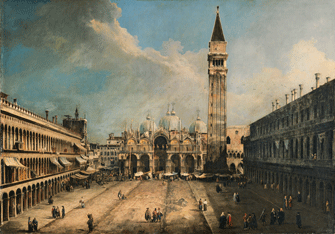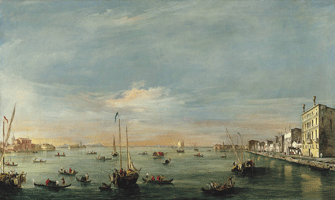Postcards from the
Serenissima

Canaletto’s “Piazza San Marco, Looking East” (1723). © Thyssen-Bornemisza Museum, MadridHave you ever felt that you had seen quite enough pretty paintings of Venice by Canaletto and Guardi and that they were all beginning to look alike? Probably not, given the immense popularity of these two prolific painters of Venetian scenes, but if you have, get thee to Paris’s Musée Jacquemart-André’s exhibition “Canaletto-Guardi: The Two Masters of Venice,” where you can rekindle your appreciation of their work as you plunge into the life of the streets and canals of Venice and bathe in the crystalline light of the sea-laced city.
Canaletto (born with the highly appropriate name of Antonio Canal in 1697; he died in 1768) did not invent the art of the veduta (landscape painting characterized by precise perspective, limpid light and depiction of daily life), a style perfected by Dutch painters, but he is probably its best-known representative, along with his successor and admirer Francesco Guardi (1712-93).
Venice’s popularity as a tourist attraction is nothing new, and visitors to the Serenissima — in the artists’ lifetimes, particularly British diplomats and aristocrats — have always wanted to take home a souvenir of it, so Canaletto actually reduced the size of his paintings to make them more portable for foreigners. The show’s curator, Bozena Anna Kowalczyk, a leading expert on the two artists, calls “The Grand Canal, Looking Northeast from the Palazzo Balbi to the Rialto Bridge” (1724-25), one of those reduced-format works, “the first postcard from Venice.”
The vedute are also fascinating records of life in Venice, with many depicting everyday activities — friends gossiping, beggars begging, laborers at work, gondoliers tying up their boats, dogs wandering, laundry flapping from balconies (on the Piazza San Marco!) and so forth — and some documenting extraordinary events like the doge’s ceremonial departure for the Lido and other festivities and solemn occasions.
One of the beauties of the exhibition, which begins with paintings by a few of Canaletto’s predecessors and also features several lovely works by his nephew, Bernardo Bellotto (1722-80), is the way it highlights the subtle differences between the paintings of Caneletto and Guardi, in some cases contrasting paintings of the same scene by each of them. Comparison points up the precision and clarity of the former and the more poetic, atmospheric touch of the latter. If you look closely, you will notice that the way Caneletto paints the waters of the canals, with little wavy marks, is rather formulaic, while Guardi really observes the colors and forms of the reflections on the water’s surface.
Like other vedutisti, Caneletto and Guardi employed a camera obscura to ensure the topographical accuracy of their views, but both used their imagination and talent to embellish what this mechanical aid could show them by playing with compositions and introducing dazzling lighting effects. When you see the glowing light in many of the paintings in the exhibition, notably Caneletto’s “Piazza San Marco, Looking East” (1722) and Guardi’s “The Giudecca Canal and the Zattere” (c. 1758) the words “Turner” and “Impressionism” will inevitably spring to mind, so obvious is their

Guardi’s “The Giudecca Canal and the Zattere” (c. 1758) © Colección Carmen Thyssen-Bornemisza en déposito en el Museo Thyssen-Bornemisza, Madrid
influence on their 19th-century admirers.
The show ends with some less familiar but no less interesting capricci (caprices), imaginary landscapes and architectural fantasies by both artists.
With postcards like these, who needs to visit the original? But don’t be surprised if you have a sudden yen to see the Serenissima again after seeing this show.
Note: the Musée Maillol is also holding a show on Canaletto, “Canaletto à Venise” (through Feb. 10, 2013), with 50 paintings of Venice by the artist, his camera obscura and his album of drawings.
Musée Jacquemart-André: 158, boulevard Haussmann, 75008 Paris. Métro: Saint-Augustin, Miromesnil or Saint-Philippe du Roule. RER: Charles de Gaulle-Étoile. Tel.: 01 45 62 11 59. Open daily, 10 a.m.-6 p.m. (until 9pm on Monday and Saturday). Admission: €11. Through January 14, 2013. www.musee-jacquemart-andre.com
Reader reaction: Click here to respond to this article (your response may be published on this page and is subject to editing).
Please support Paris Update by ordering books from Paris Update’s Amazon store at no extra cost. Click on your preferred Amazon location: U.K., France, U.S.
More reviews of Paris art shows.
© 2012 Paris Update
